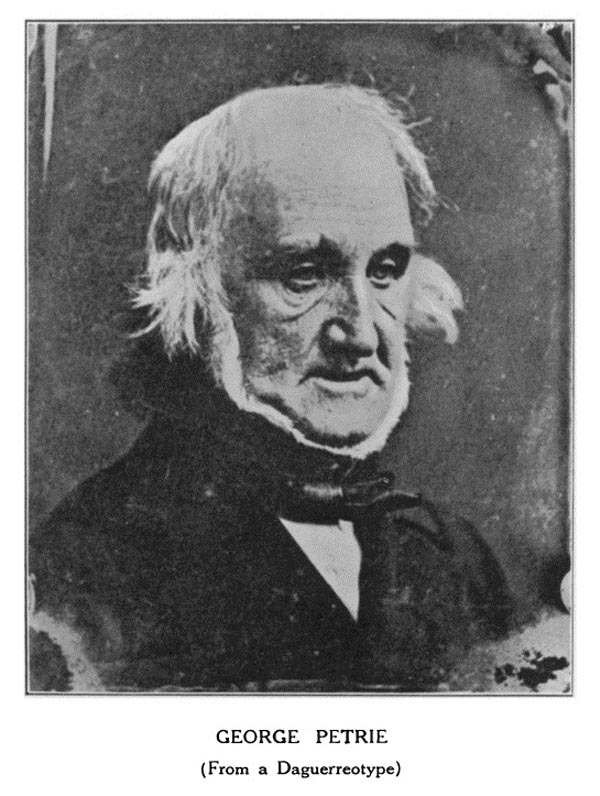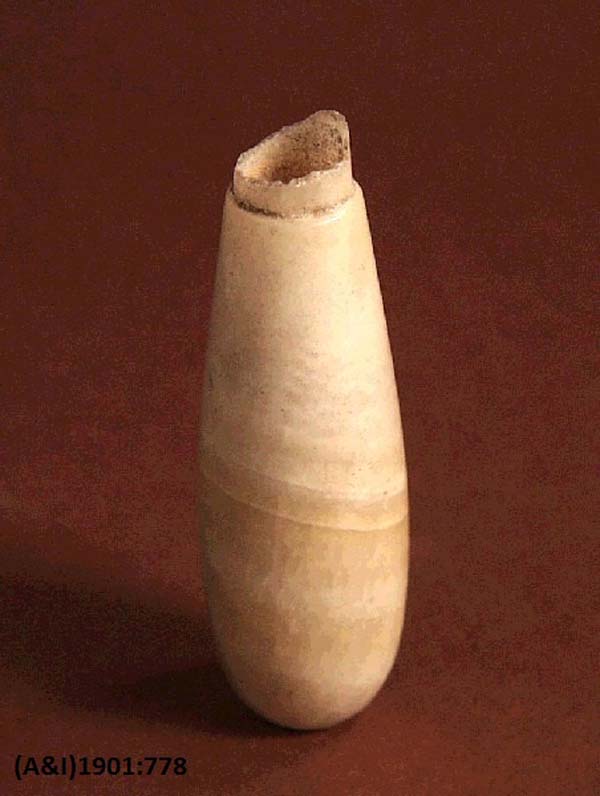Unknown
Pair of Egyptian Jars from a Ringfort at Lucan, Co. Dublin
Could two c. 2,500 year old Egyptian alabastra have been found in an Iron Age ringfort?
By Rachel Flynn
Father of Irish Archaeology
When the Antiquities inventory project got underway just over four years ago, it took the team some time to become familiar with the numerous antiquarian catalogues that contribute to 150+ years of object registration.
One such catalogue, first compiled by William F. Wakeman in 1867, registered the display collection of the late George Petrie, artist and antiquarian, often referred to as the ‘father of Irish archaeology’. While scanning the pages, hunting for axeheads, ring-pins, horse-trappings etc., a curious pair of entries kept jumping out:
“1310a. Portion of a stone bottle found in the rath at Lucan”.
“1310b. A perfect stone bottle from same place”.
The mysterious objects are revealed, or are they?
It was hard to imagine what they could be but it was only a matter of time before they clarified the matter themselves - or further confused it as it turned out! Lying side by side in a drawer were two apparent stone ‘bottles’, each no bigger than a 500ml bottle of water you might pick up in a newsagent and certainly not the type we would ever expect to find in a ringfort at Lucan or elsewhere in an Irish context.

What exactly is an 'alabastron'?
The most likely place to find an equivalent to these elongated, round-bottomed vessels would be Egypt, Greece or the Middle-East where similar carved stone vessels, known as alabastra, were used to hold perfumed or therapeutic oils. Dating as far back as the Egyptian New Kingdom (16th- 11th century BC), their name is derived from the word alabaster, the original material of manufacture. Ceramic and glass versions were also developed, particularly by the Greeks who are even more commonly associated with the alabastron than the Egyptians due to their popularisation of the form and their capacity to mass-produce it.
Could we have Egyptian alabastra in an Irish context?
Our vessels, with their fine-grained, greyish-white walls, suggested gypsum to NMI geologist, Matthew Parkes, of which gypsum alabaster is a form. Evidence of rotary carving could be seen on the interior base surface of the broken specimen suggesting it was hollowed out in the same manner as an alabastron would have been. Their unlikely findplace was referred to as a ‘Danish Rath’ adjoining the village of Lucan in the first ever issue of the Dublin Penny Journal in 1832. It is now listed in the National Monuments Database as a ringfort with souterrain in the townland of Lucan and Pettycannon, Co. Dublin.

Figure 3: Egyptian alabastron from Qasr el Banat, Lebanon (DC:1901.778)
From certainty to scepticism to consideration...
Petrie himself was certain of their origin referring to the “Egyptian alabaster bottle found in a rath at Lucan” (Petrie, 1878). Later writers were less easily convinced. In detailing a small motif-piece from the same site, Uaininn O’Meadhra referred to them as being possible Roman, Teutonic or Merovingian objects. The problem was that previous interpretations were limited to Wakeman’s description because the vessels were not located at that stage. It was therefore easy to dismiss the least likely scenario put forward by Petrie, far more difficult when it is staring you in the face!
Learn more…
These objects are currently in the museum’s reserve collection along with a small example from the Graeco-Roman period (3rd- 1st century BC) at Qasr-el-Banat, Fayum, Egypt. You can find a selection of carved alabaster vessels on display in our Ancient Egypt exhibition.
Read more about these objects
-
Ó Meadhra, U. (1987). Early Christian, Viking and Romanesque art motif-pieces from Ireland: 2. a discussion on aspects of find-context and function. Stockholm: Almqvist & Wiksell International.
-
Petrie, G., & Stokes, M. (1872-78). Christian inscriptions in the Irish language. Dublin.
Location:
Pair of Egyptian Jars from a Ringfort at Lucan, Co. Dublin is located at:
In Storage
Previous artefact:
Next artefact:
Pair of Silver Reliquaries from the Dawson Collection
